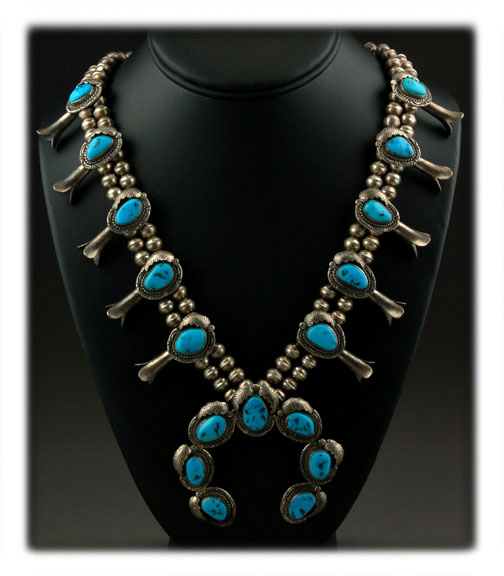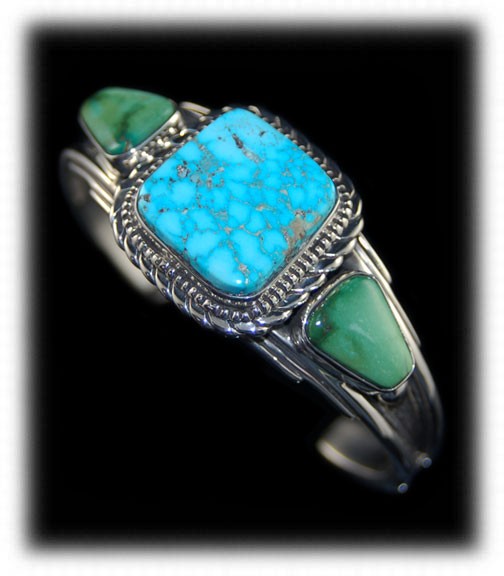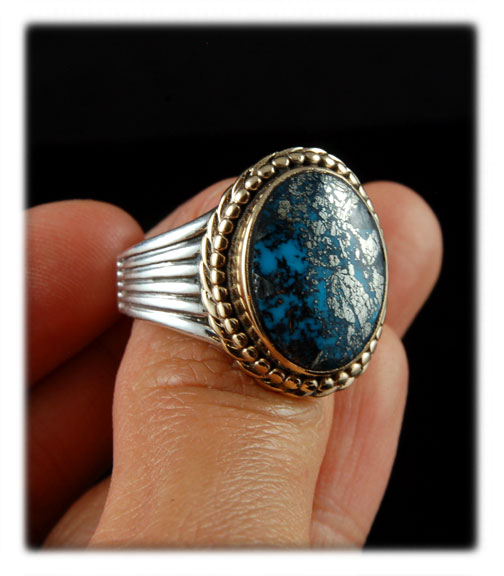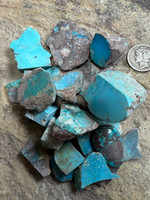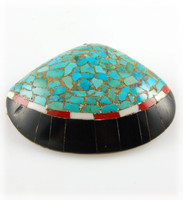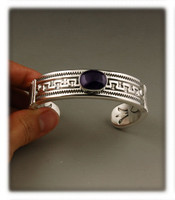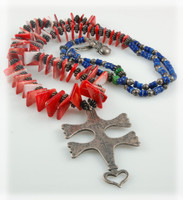 Loading... Please wait...
Loading... Please wait...- 970-759-1040 Text / Voice
- Gift Certificates
- My Account
Currency Displayed in
- Home
- Turquoise Learning Center
- Turquoise Mines List
- American Turquoise
- Morenci Turquoise
Categories
Morenci Turquoise
Morenci Turquoise
Morenci Turquoise
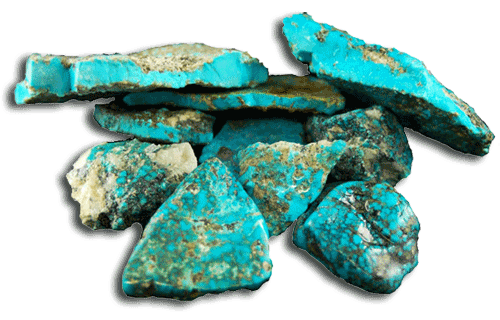
|
One of the most famous and well known American Turquoise mines is the Morenci Turquoise mine form Southern Arizona. This mine was a major producer of natural gemstones that were used commercially for years in predominately Southwestern and Native American Jewelry. The Morenci Turquoise mine was famous for its beautiful true blue Turquoise. Most of the material from this famous mine was a true blue. The mine is also famous for its beautiful Pyrite matrix which is one of the finger prints of the mine. Nothing is more beautiful then sky blue Turquoise with silver colored iron pyrite matrix, or the rare golden pyrite matrix in natural Morenci Turquoise. The mine produce a wide variety of Turquoise from clear sky blue to pyrite matrix material to spider web to aqua blue green stones. Throughout the years gems from this mine were a stable in American Indian Jewelry made by all tribes including Navajo Jewelry, Zuni Jewelry and more. When look at old pawn or vintage Turquoise jewelry you will find a ton of beautiful natural Morenci Turquoise. Today this beautiful classic Turquoise is hard to find. The mine has been closed for many, many, many years. Ultra highgrade material from this mine as with most mines was always scarce, and today is more rare than hens teeth. Read on
|
Vintage Morenci Turquoise Necklace |
Morenci Turquoise Examples
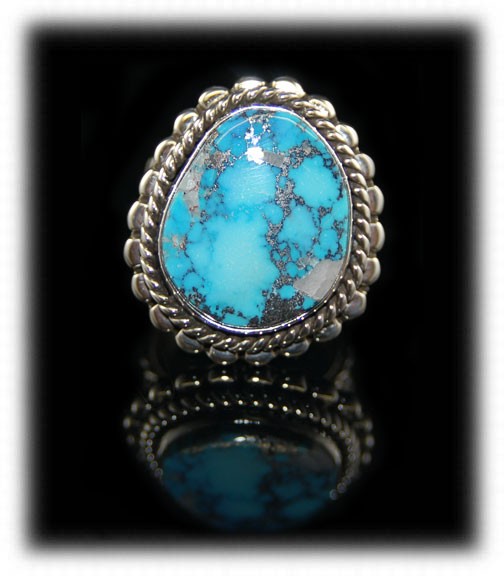 |
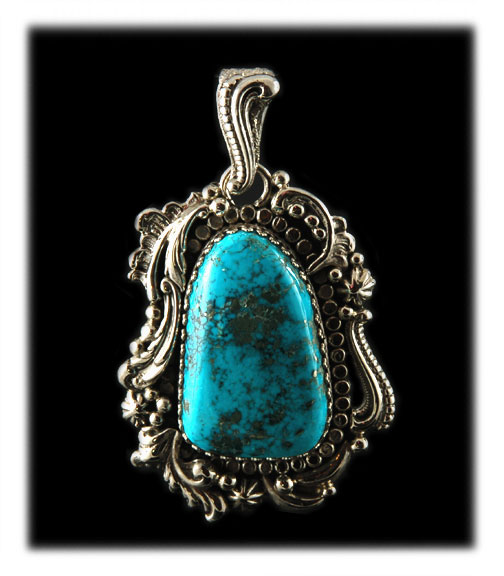 |
Above to the left is a great example of the "Robin's Egg" blue variety of natural Morenci Turquoise and the gemstone cabochon features nature iron pyrite spider web matrix and Quartz matrix. This type of spider web matrix made from silver colored iron Pyrite is a major fingerprint of Morenci Turquoise. Quatz in Turquoise is also very rare. This fabulous Sterling Silver dinner ring was handmade in Durango, Colorado by John Hartman.
Above to the right is a fancy Victorian style Sterling Silver pendant by John Hartman with a wonderful example of deep blue Morenci Turquoise with iron pyrite matrix. Both of the piece of above are classic examples of natural Morenci Turquoise from Arizona.
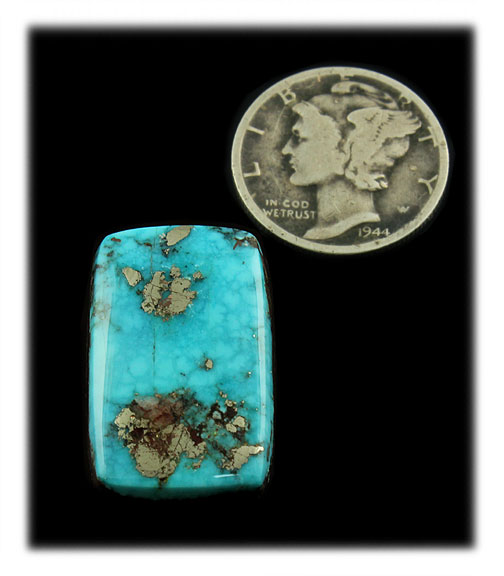 |
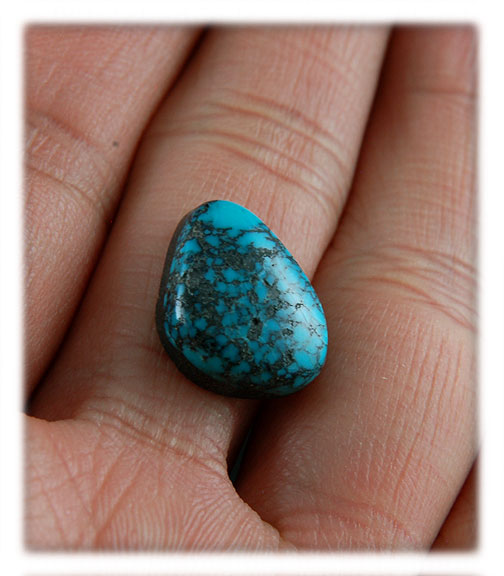 |
Above to the left is a beautiful example of a natural Morenci Turquoise cabochon with beautiful iron pyrite matrix and rare water web matrix. This fine piece of Arizona Turquoise is a great example of natural gem Turquoise from the Morenci mine. Above to the right is a hand cut cabochon of ultra grade spiderweb Morenci Turquoise from Arizona. This material was less than 5% of the production of the mine. This is a wonderful example of ultra rare and collectible natural Turquoise from the Morenci mine.
General Morenci Turquoise History
|
High Grade Morenci Turquoise and Broken Arrow Turquoise Bracelet by John Hartman |
Morenci Turquoise was mined in Greenlee County in southeastern Arizona out of a large metal mine operation. Morenci is highly prized for its beautiful blue colors, which vary from a light to a very dark blue. Also for its unusual matrix of iron pyrite or "fool’s gold" that when polished often resembles silver. The Turquoise was a byproduct of the Morenci copper mine in Arizona. For many years heavy-equipment operators at the mine would "lunch box" the high-grade Turquoise out. The March 1977 edition of the “International Turquoise Annual” states, "Many years ago, while mining for copper, workers unearthed a large zone of Turquoise-bearing rock and, realizing its value, began working this zone, neglecting the copper. In order to ensure copper production continuing, the copper company that held the mine at the time took the entire Turquoise deposit, which was extensive, and buried it under thousands of tons of waste rock from the pit and it is still sitting there. Uncovering it would be too massive and expensive a project." From 1956 to 1984 the Turquoise rights were granted to William "Lucky" Brown who had an extensive mining career that included working the mine at Villa Grove in Colorado. The Morenci mine produced high quantities and was marketed through family operated trading posts in New Mexico and Arizona. Lucky retired in 1982 and his sons continued to mine the Turquoise until the lease ended. |
|
The Clifton-Morenci mining district lies eight miles due north of the Gila and San Francisco rivers and is near the Arizona-New Mexico border. The most reliable report states that a miner named Henry Clifton in 1864 first noted the area’s mineral resources. Within two years an Army scout, Robert Metcalf, discovered the blue and green copper stained outcropping that he and a few associates claimed as the famous Longfellow mine, which went on to produced 20 million pounds of copper. In 1872 a Detroit mining man named William Church purchased a group of claims with his Detroit Copper Mining Company that he had organized. Church then proceeded to develop mining operations at Morenci, Arizona. Development work was no easy task. Work was all done by hand, water was scarce, transportation was slow, furnace like desert conditions and Geronimo, who was always a formidable adversary. But with all of the above problems by 1880 copper was being produced. Church eventually sold his claims to Phelps Dodge and Company. The Morenci mine is the largest copper mine in the US and produces over 750 million pounds of copper a year. It stretches for miles across the landscape. It is thousands of feet from the top of the mountains to the dug out bottoms and shades of bluish-green from the richness of copper that first led miners to the area are still present. Today’s southwestern copper mines produce little Turquoise, with the change of mining methods to crushing and acid washing the Turquoise is destroys in the copper ore which a sad situation.
|
Here is a rare deep blue Morenci Turquoise |
The fact that Morenci Turquoise is no longer being mined along with its beautiful blues and its silver colored matrix make Morenci very sought after in today’s Turquoise market. Learn More About Turquoise | Arizona Turquoise Mines | Turquoise Mines List | Turquoise History




